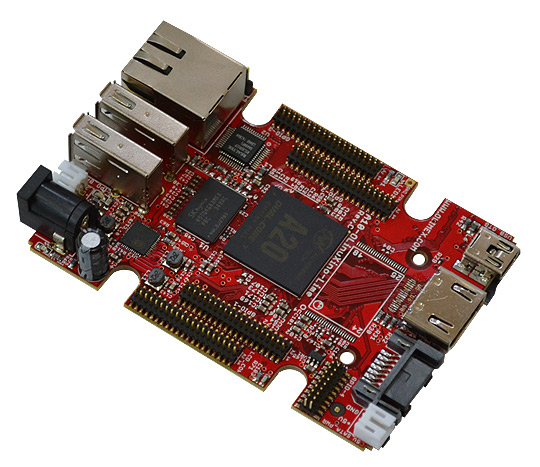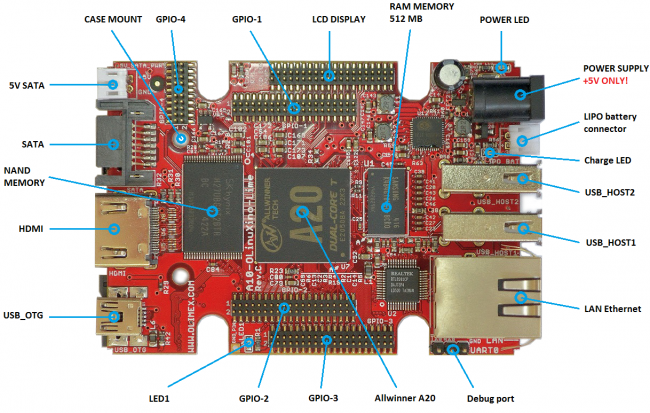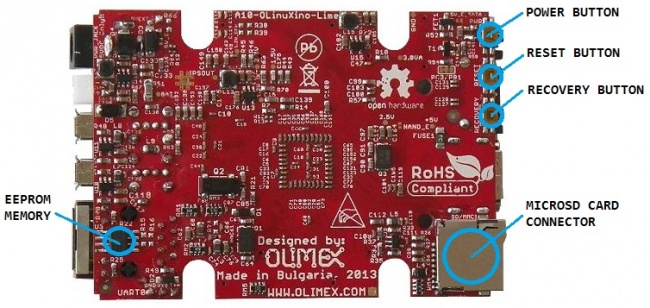A20-OLinuXino-LIME
A20-OLinuXino-LIME looks identical to A10-OLinuXino-LIME, except for the more powerful A20 processor. The A10 and the A20 processors are pin-to-pin compatible. Because of the processor, software-wise the board is closer to A20-OLinuXino-MICRO than to the A10-OLinuXino-LIME. This resemblance to other designs definitely might speed the development on the board - a lot of software written for A20-OLinuXino-MICRO might work out-of-the-box with A20-OLinuXino-LIME. Additionally, pinout tables, GPIO maps, etc released for A10-OLinuXino-LIME would apply to A20-OLinuXino-LIME
A20-OLinuXino-LIME features:
- A20 Cortex-A7 dual-core ARM Cortex-A7 CPU and dual-core Mali 400 GPU
- 512MB DDR3 RAM memory
- optional 4GB NAND FLASH memory
- SATA connector with 5V SATA power jack
- HDMI FullHD 1080p
- 2x USB Low-Full-High-Speed hosts with power control and current limiter
- USB-OTG with power control and current limiter
- 100MBit native Ethernet
- LiPo Battery connector with battery-charging capabilities
- LCD connector compatible with with 4.3", 7.0", 10.1" LCD modules from Olimex
- 160 GPIOs on three GPIO connectors
- MicroSD card connector
- DEBUG-UART connector for console debug with USB-SERIAL-CABLE-F
- status LED
- Battery charge status LED
- Power LED
- 2KB EEPROM for MAC address storage and more
- 2 BUTTONS with ANDROID functionality + RESET button
- 2 mount holes
- 5V input power supply, noise immune design
- PCB dimensions: 84 x 60 mm
Contents
- 1 Official Images from OLIMEX
- 2 Documents
- 3 Hardware
- 4 Software
- 5 How To?
- 5.1 How to generate boot-able SD-card Debian Linux image for A20-OLinuXino-LIME?
- 5.2 How to change HDMI, VGA and LCD resolutions?
- 5.3 How to detect and enable the Ethernet controller (if it is disabled by default)?
- 5.4 How to download new Android image to the NAND memory of my A20 board?
- 5.5 How to add STK1160 video capture driver support in Kernel 3.4
Official Images from OLIMEX
The file for download xxxx.7z is an archive of xxx.img file. So in order to write the image on SD card you have to unzip xxx.7z file and:
- For Windows:
Use 7zip and then use Win32DiskImager.exe (http://sourceforge.net/projects/win32diskimager/) for image writing
- For Linux
Use p7zip package. If you have no installed 7zip then type
#apt-get install p7zip
Copy a10_Lime_debian_second_release.7z file in your directory and unzip it with
#7za e a10_Lime_debian_second_release.7z
The output should be a new 4GB file named a10_Lime_debian_second_release.img Put 4GB SD card in your card reader and type
# ls /dev/sd
Then press two times <TAB> you will see a list of your sd devices like sda sdb sdc note that some of these devices may be your hard disk so make sure you know which one is your sd card before you proceed as you can damage your HDD if you choose the wrong sd-device. You can do this by unplugging your sd card reader and identify which "sd" devices remove from the list. Once you know which device is your sdcard like sda use this text instead of the sdX name in the references below:
#dd if=a10_Lime_debian_second_release.img of=/dev/sdX
Linux
A20-OLinuXino-LIME Debian image with Kernel 3.4.90+
Note: the A20-Debian card which we have in our web store contains the same image on 4GB Class10 fast micro SDcard, if you want to use this image please use card of Class10 speed or the performance of Linux will be very slow.
Note: in the previous Debian releases the Ethernet was auto-detected and initialized during boot BUT this was causing big delays in the start-up of the board if you didn't want to use Ethernet or if there wasn't Ethernet cable connected.
You can enable it by following these two steps:
1. To check under what name the LAN is associated write "ifconfig –a"
2. If, for example, it is under eth0 name, then write: "dhclient eth0"
This should enable the Ethernet and then SSH would also be available.
Android
NAND Flash image for Android 4.2.2 with 7″ LCD 800×600 pixels
NAND Flash image for Android 4.2.2 with 10″ LCD 1024×600 pixels
4GB SD-card image for Android 4.2.2 with 7″ LCD 800×600 pixels
Documents
A10-OLinuXino-LIME user's manual
User's manual for A10-OLinuXino-LIME and A10-OLinuXino-LIME-4GB
A20 Brief
A20 Datasheet
A20 User Manual
Hardware
LIME shields
Eagle and KiCAD shield templates for LIME
GPIO description
A10-OLinuXino-LIME GPIO description
A template that might be used to create custom shields or own adapters might be downloaded for Eagle or KiCad at the GitHub here: shield template
Power supply and consumption
A20-OLinuXino-LIME requires 5V regulated power supply external source. regulated means that the power supply adapter should provide exactly 5V no matter loaded or unloaded (some cheap wallwart adapters are not regulated and under no load their power supply may be higher than 5V although marked as 5V power supply, please measure with voltmeter if your power supply provide 5V as if you connect more than 5V to LIME it will be damaged!!!)
The power jack is standard OLIMEX Power jack.
A20-OLinuXino-LIME can be powered from three sources:
- +5VDC voltage applied PWR jack
- +3.7V from LiPo re-chargable battery connected to LiPo board connector
- +5V applied to USB-OTG connector
Power consumption is as follows:
- LiPo 3.7V power battery: 1.2W
- +5VDC input power: 1.3W
Comparison table of power consumption might be found at the following link.
LiPo battery allow backup power supply when main power is interrupted. A20-OLinuXino-LIME have power managment IC which charge the battery when main power is present, when power is interrupted the LiPo battery automatically provide backup power supply. Step-up converter prvide 5V for the USB peripherials too. For LiPo batteries we recommend these:
Board dimensions
A20-OLinuXino-LIME basic dimensions in mils: 3305.5 x 2347.0
Some additional measures might be seen in the image here: link
CAD files
A10-OLinuXino-LIME is Open Source Hardware, CAD files are available at GitHub
The CAD product used to design OLinuXino is Eagle and you can download evaluation free version from their web.
Board Layout
Software
Linux Commands
Linux-Commands Brief Linux Command reference
Python
[pyA10 is Python library for access to A10-OLinuXino-LIME GPIOs, I2C, SPI]
Use:
#!/usr/bin/env python import A10_GPIO as GPIO #init module GPIO.init() #configure module GPIO.setcfg(GPIO.PIN#, GPIO.OUTPUT) GPIO.setcfg(GPIO.PIN#, GPIO.INPUT) #read the current GPIO configuration config = GPIO.getcfg(GPIO.PIN#) #set GPIO high GPIO.output(GPIO.PIN#, GPIO.HIGH) #set GPIO low GPIO.output(GPIO.PIN#, GPIO.LOW) #read input state = GPIO.input(GPIO.PIN#) #cleanup GPIO.cleanup()
GPIO under Linux
GPIOs are located in /sys/class/gpio directory. Note that first you have to export GPIOs. For example:
add gpioPH2
root@A10:~# echo 20 > /sys/class/gpio/export
make PH2 output
root@A10:~# echo out > //sys/class/gpio/gpio20_ph2/direction
turn on onboard LED(connected to PH2)
root@A10:~# echo 1 > /sys/class/gpio/gpio20_ph2/value
turn off onboard LED(connected to PH2)
root@A10:~# echo 0 > /sys/class/gpio/gpio20_ph2/value
Full list with supported GPIOs is:
gpio21_ph7 gpio33_ph20 gpio45_pb12 gpio57_pi2 gpio69_pi14 gpio10_pg11 gpio22_ph9 gpio34_ph21 gpio46_pb13 gpio58_pi3 gpio6_pg5 gpio11_pc3 gpio23_ph10 gpio35_ph22 gpio47_pb14 gpio59_pi4 gpio70_pi15 gpio12_pc18 gpio24_ph11 gpio36_ph23 gpio48_pb15 gpio5_pg4 gpio71_pi16 gpio13_pc19 gpio25_ph12 gpio37_pb3 gpio49_pb16 gpio60_pi5 gpio72_pi17 gpio14_pc20 gpio26_ph13 gpio38_pb4 gpio4_pg3 gpio61_pi6 gpio73_pi18 gpio15_pc21 gpio27_ph14 gpio39_pb5 gpio50_pb17 gpio62_pi7 gpio74_pi19 gpio16_pc22 gpio28_ph15 gpio3_pg2 gpio51_ph24 gpio63_pi8 gpio75_pi20 gpio17_pc23 gpio29_ph16 gpio40_pb6 gpio52_ph25 gpio64_pi9 gpio7_pg6 gpio18_pc24 gpio2_pg1 gpio41_pb7 gpio53_ph26 gpio65_pi10 gpio8_pg7 gpio19_ph0 gpio30_ph17 gpio42_pb8 gpio54_ph27 gpio66_pi11 gpio9_pg8 gpio1_pg0 gpio31_ph18 gpio43_pb10 gpio55_pi0 gpio67_pi12 gpiochip1 gpio20_ph2 gpio32_ph19 gpio44_pb11 gpio56_pi1 gpio68_pi13
How to edit board configurations and definitions in the official Debian Linux?
It is described in this wiki article: How_to_edit_board_configurations_and_definitions_in_the_official_Debian_Linux.
Add Voice to your OLinuXino project
Installation of Festival on OLinuXino
How To?
How to generate boot-able SD-card Debian Linux image for A20-OLinuXino-LIME?
To be added
Note that Linux-Sunxi Kernel is a work-in-progress, this means you can try the current stage/sunxi-x.x branch but if something is broken and doesn't work just revert to the git tags we give in the blog and they should work for sure
Sunxi u-boot loader The linux-sunxi git page contains a lot of sources for all Olimex Allwinner boards.
How to change HDMI, VGA and LCD resolutions?
The default SD card setup is made with settings for HDMI 720p/60Hz. If you want to change to some other LCD, VGA or HDMI resolution then you have to start change_display.sh script file in /root directory.
Type:
./change_display*
or
./change_display_a20_lime.sh
and press "Enter".
Then choose the resolution and the interface(LCD, HDMI). Note that the selection of a specific resolution is done by navigating with the arrow keys and pressing "space" button. Make sure the asterisk marks your selection properly.
The supported resolutions are:
For LCD:
- 1. 4.3" (480x272)
- 2. 7" (800x480)
- 3. 10" (1024x600)
- 4. 15.6" (1366x768)
Important: initially the boards are calibrated for a specific display. If you re-write the image (no matter whether the SD card or the NAND memory) you would need to use a mouse to calibrate the display initially. It might be impossible to calibrate it via touching the display.
For HDMI:
- 0. 480i
- 1. 576i
- 2. 480p
- 3. 576p
- 4. 720p50
- 5. 720p60
- 6. 1080i50
- 7. 1080i60
- 8. 1080p24
- 9. 1080p50
- 10. 1080p60
For VGA: (note that the VGA signals are routed to custom 6 pin connector and you need from adapter to standard VGA connector)
- 0. 1680x1050
- 1. 1440x900
- 2. 1360x768
- 3. 1280x1024
- 4. 1024x768
- 5. 800x600
- 6. 640x480
- 7. 1920x1080
- 8. 1280x720
How to detect and enable the Ethernet controller (if it is disabled by default)?
Note: in the previous Debian releases the Ethernet was auto-detected and initialized during boot BUT this was causing big delays in the start-up of the board if you didn't want to use Ethernet or if there wasn't Ethernet cable connected.
You can enable it by following these two steps:
1. To check under what name the LAN is associated write "ifconfig –a"
2. If, for example, it is under eth0 name, then write: "dhclient eth0"
This should enable the Ethernet and then SSH would also be available.
How to download new Android image to the NAND memory of my A20 board?
To repair the image on the NAND re-upload it following these steps:
- 1. Install and run PhoenixSuit (can be found here: download from google drive).
- 2. Go to firmware tab of the program and point to a valid Android image (the latest official one may also be downloaded above).
- 3. Disconnect the power supply and USB cable from the A20 board.
- 4. Press and hold RECOVERY button, apply power supply 5V, release RECOVERY button.
- 5. Connect USB cable to the mini USB connector.
- 6. You will be asked for drivers for the bootloader. Navigate to the folder where you extracted the PhoenixSuit and install the drivers from the respective executables (or manually point the installer to the drivers folder in the PhoenixSuit installation path).
- 7. PhoenixSuit will detect the board and would ask for the method of writing the image. Choose method of writing the image and confirm your wish to write the image.
- 8. Wait till upgrade succeeds
Note that it is not recommended to have your mini USB connected to an external USB hub. This might cause delays and might distort the signal levels. Always test with the USB connected straight to the USB ports of your computer.





